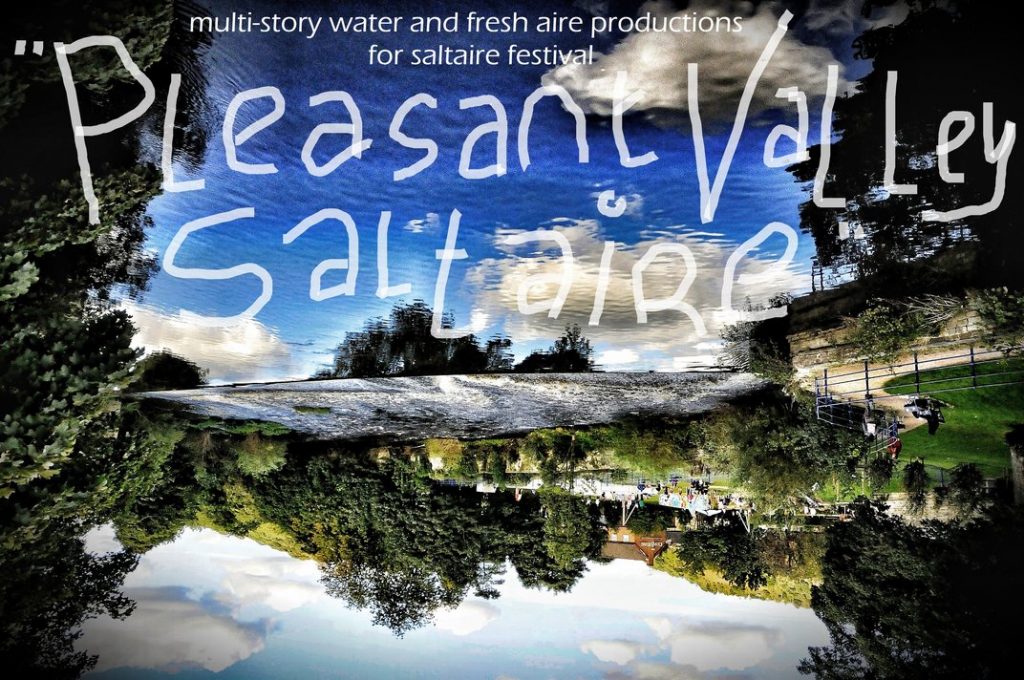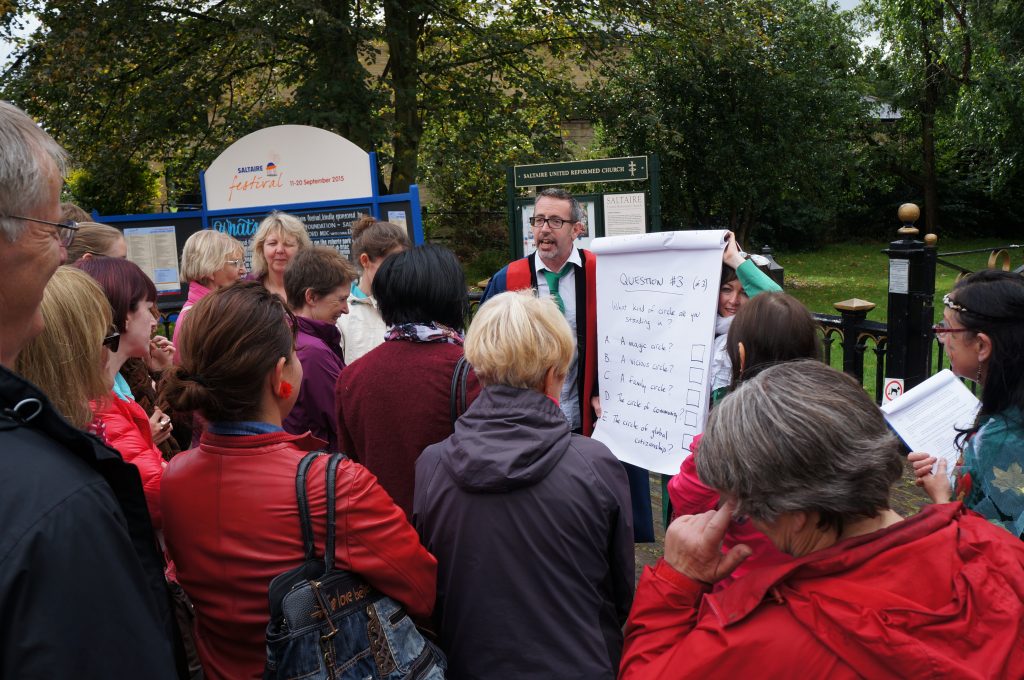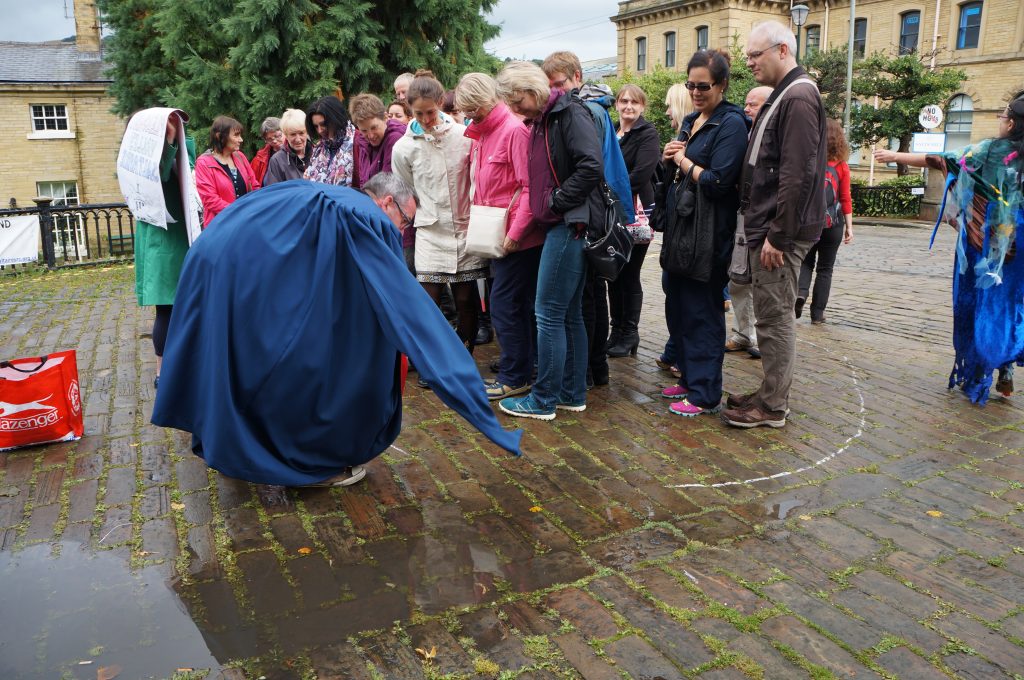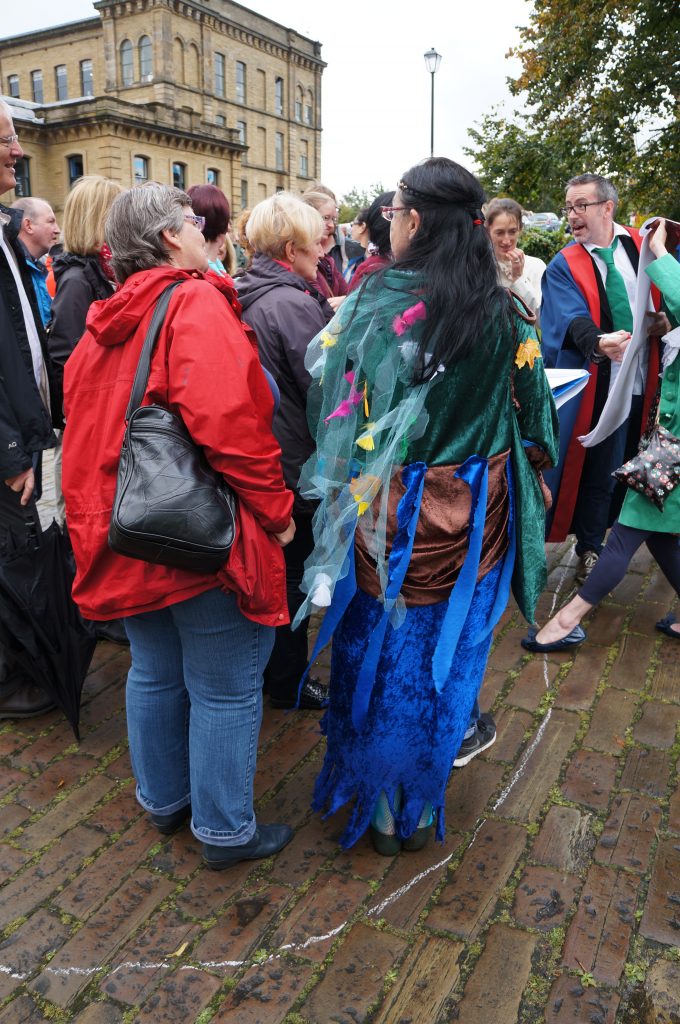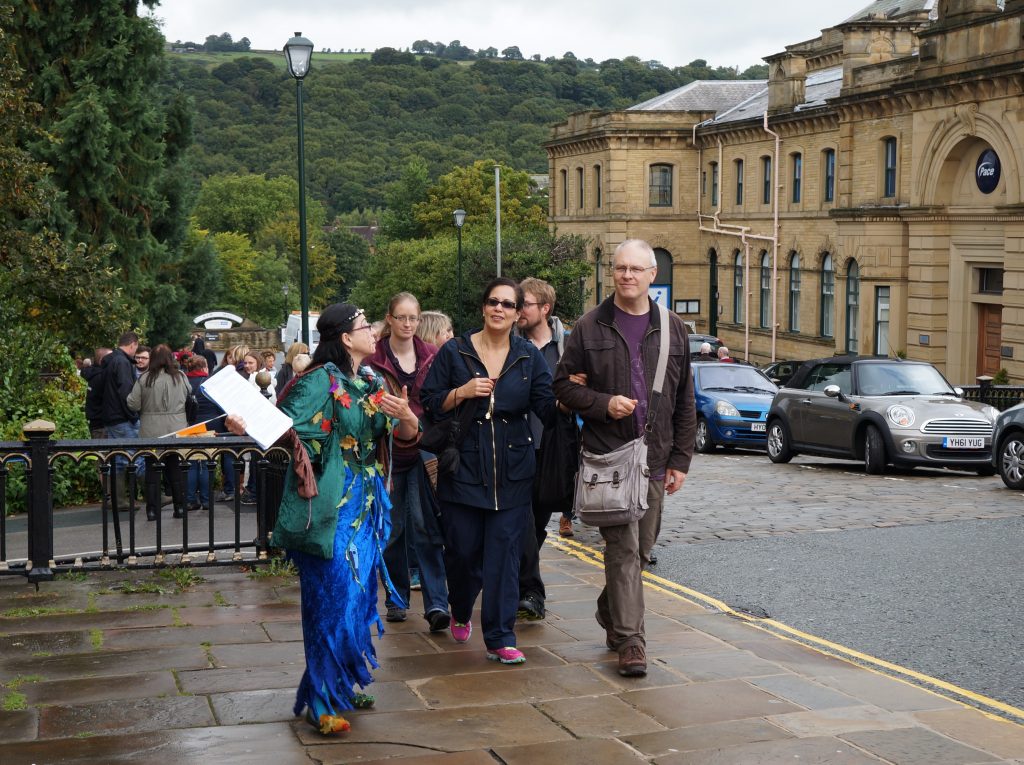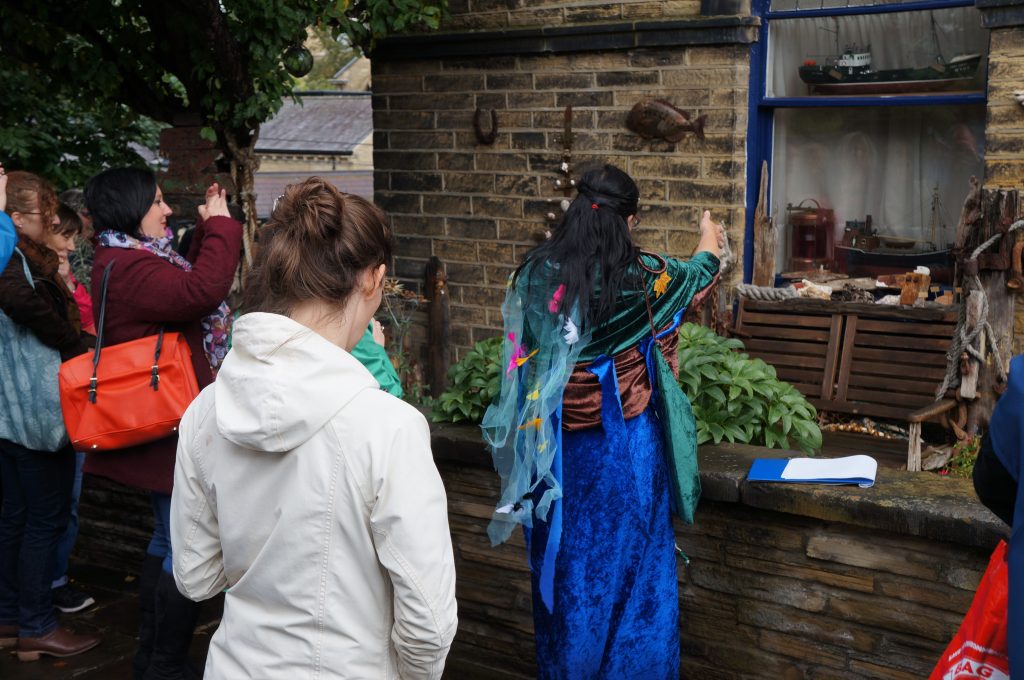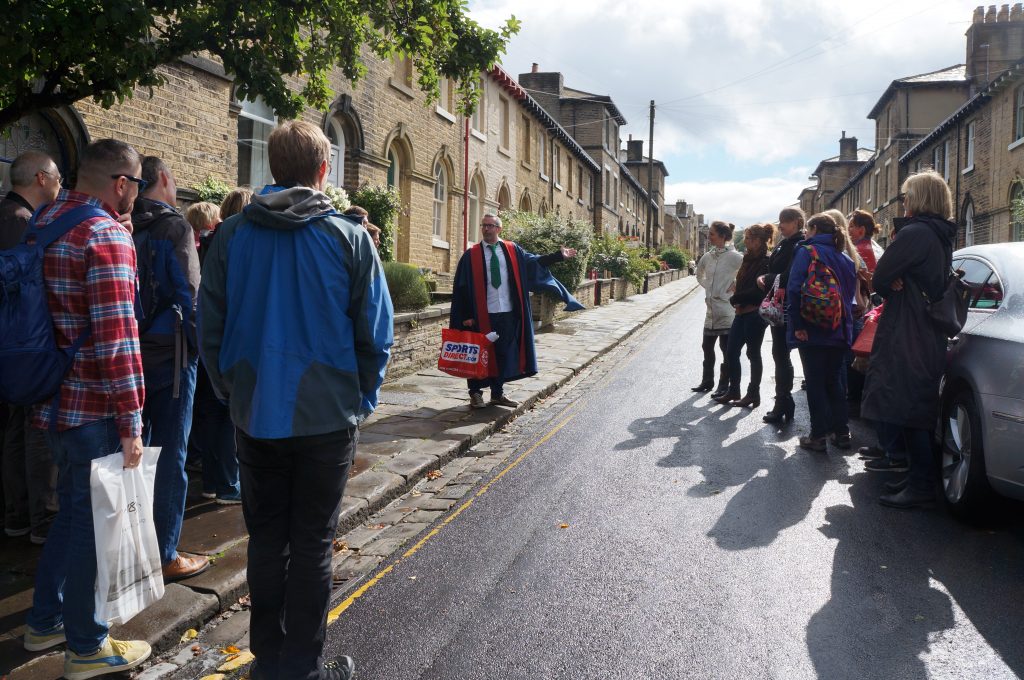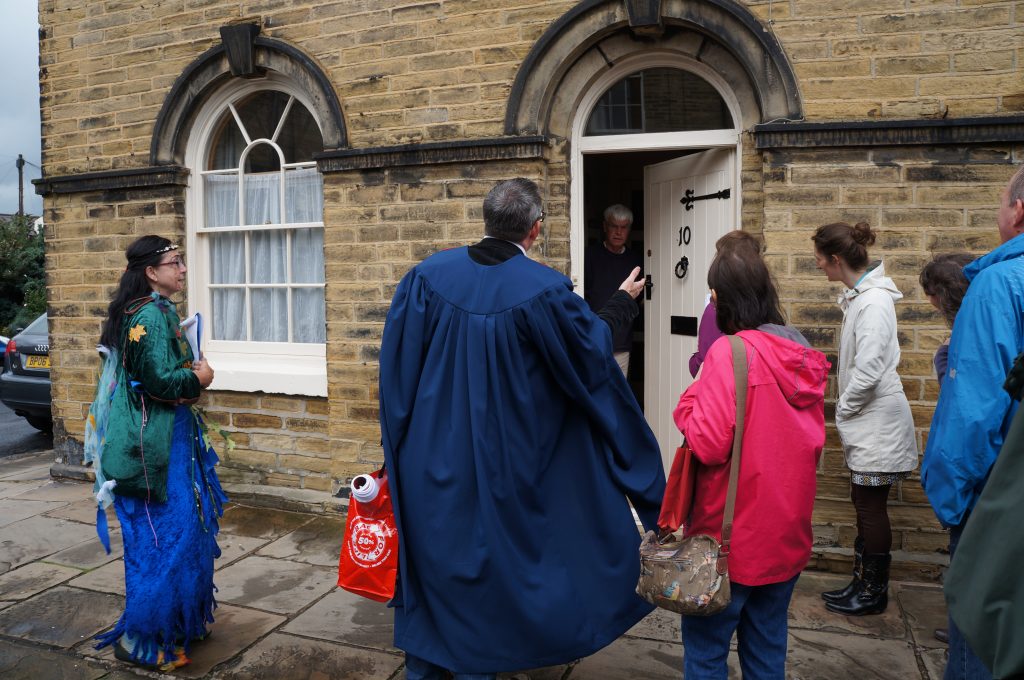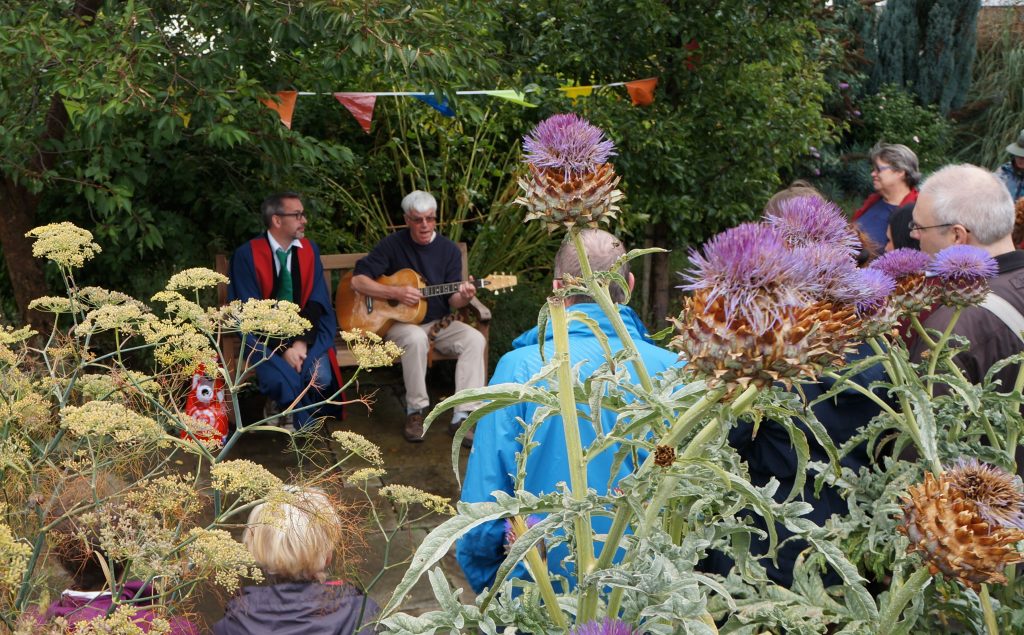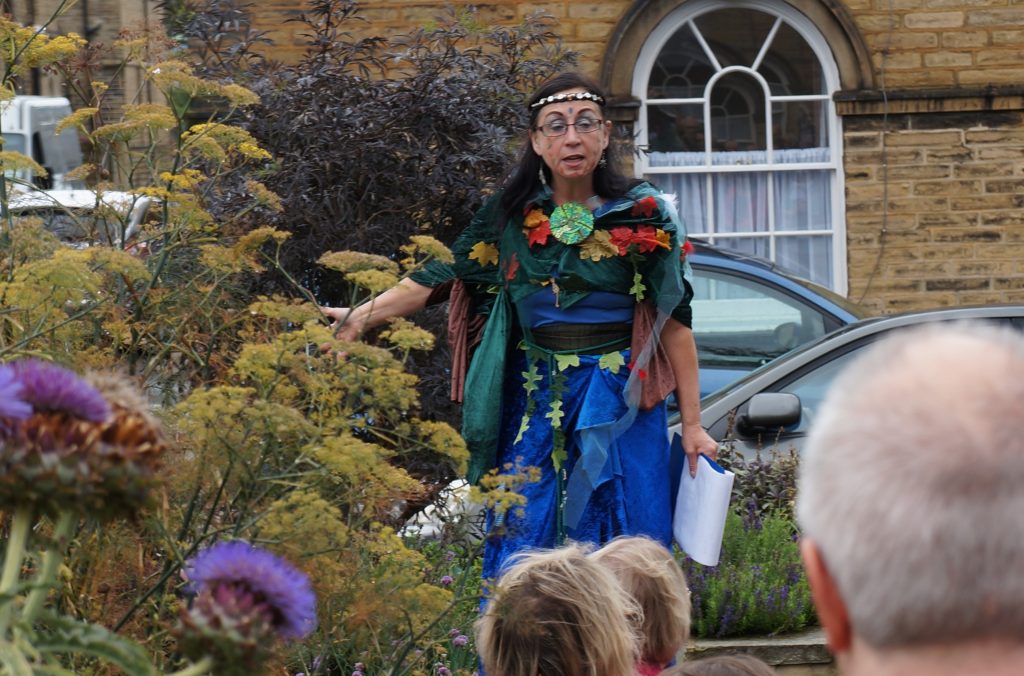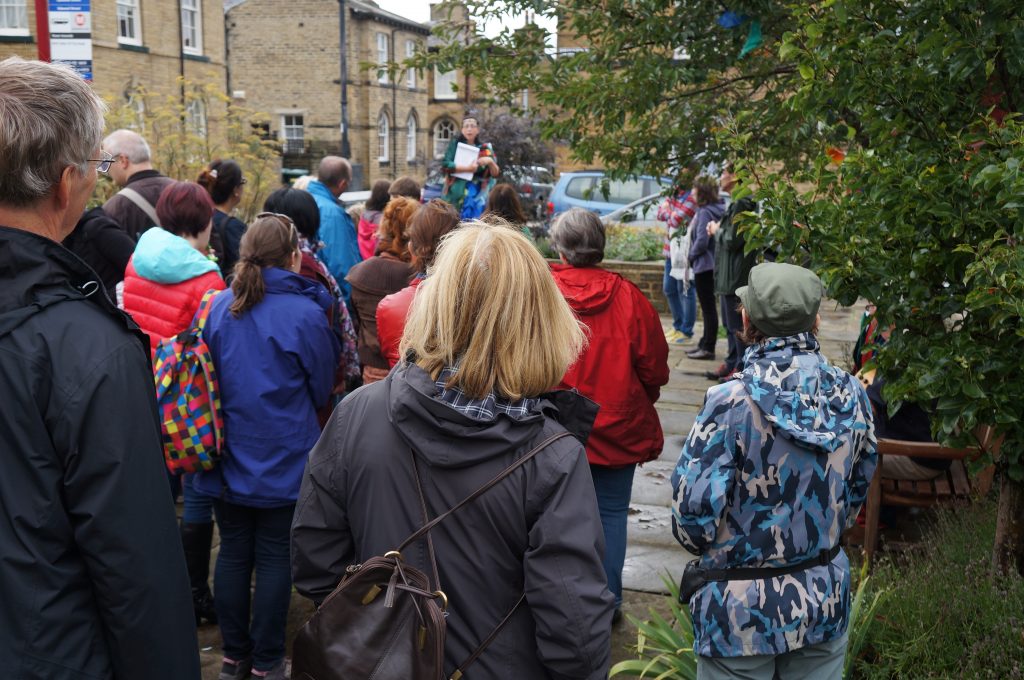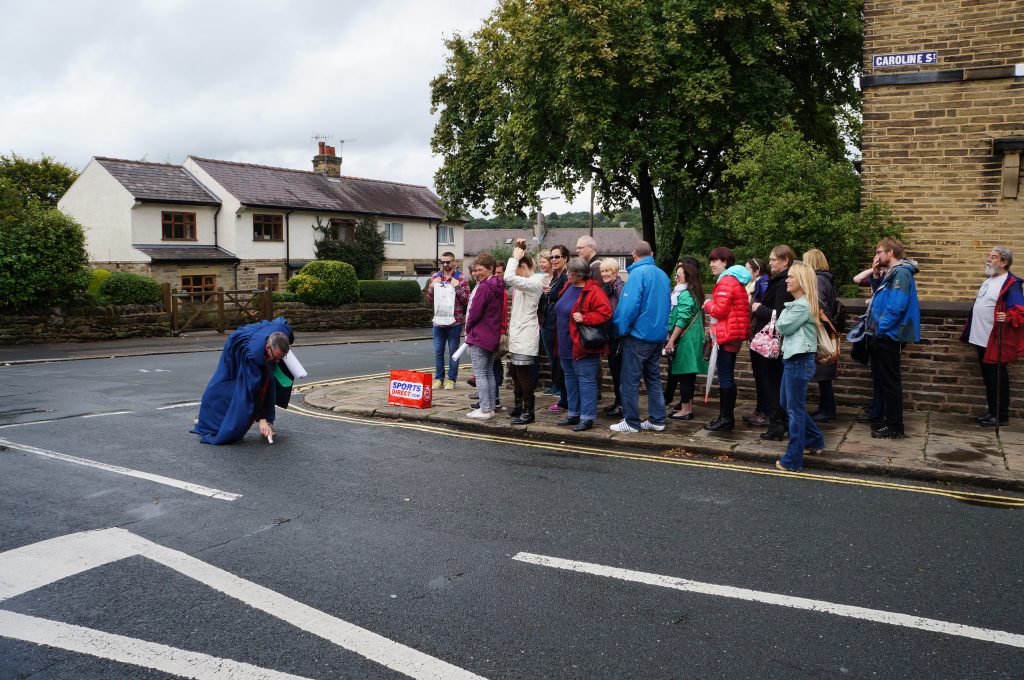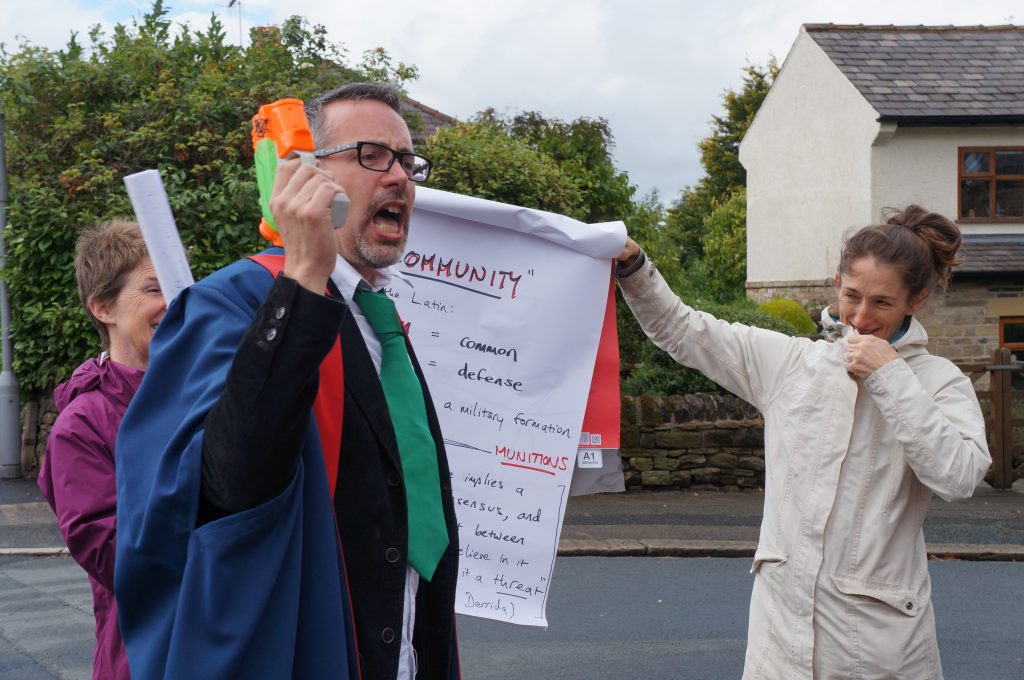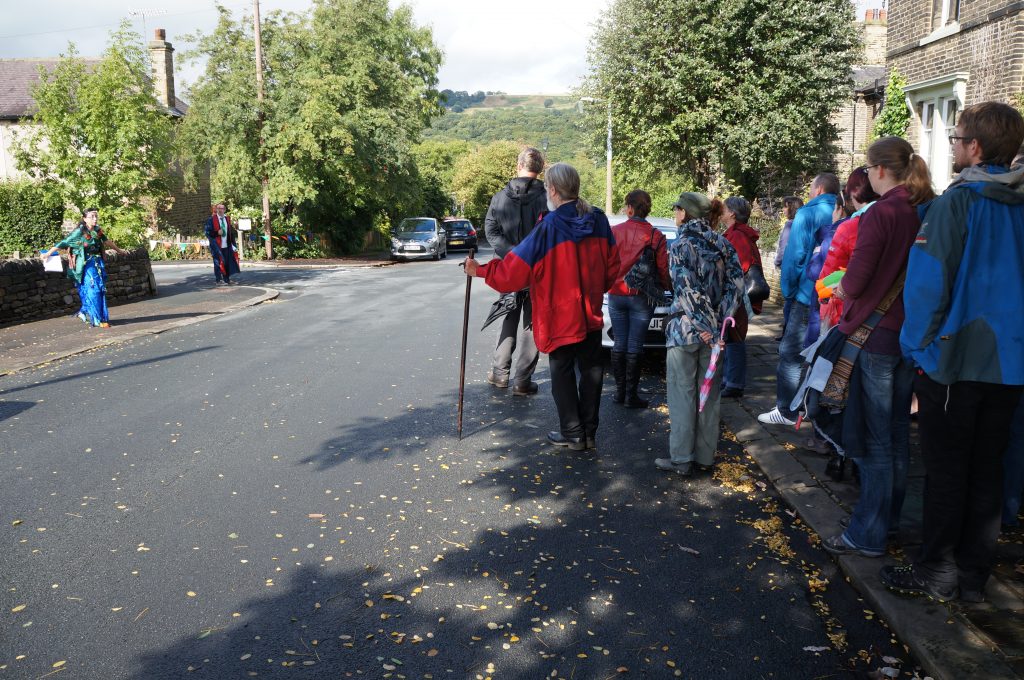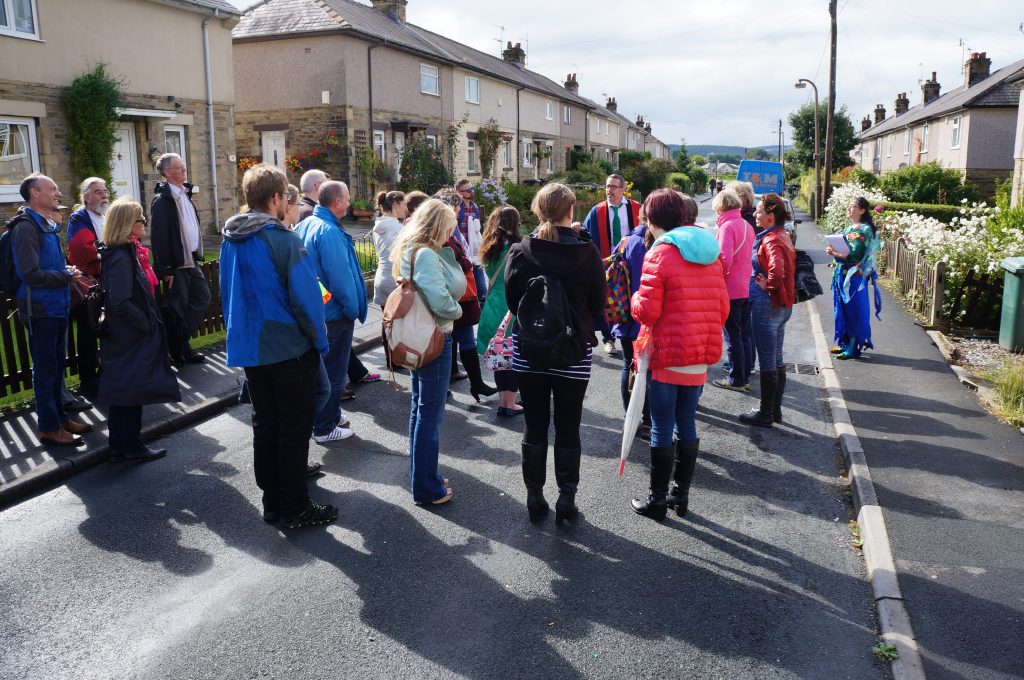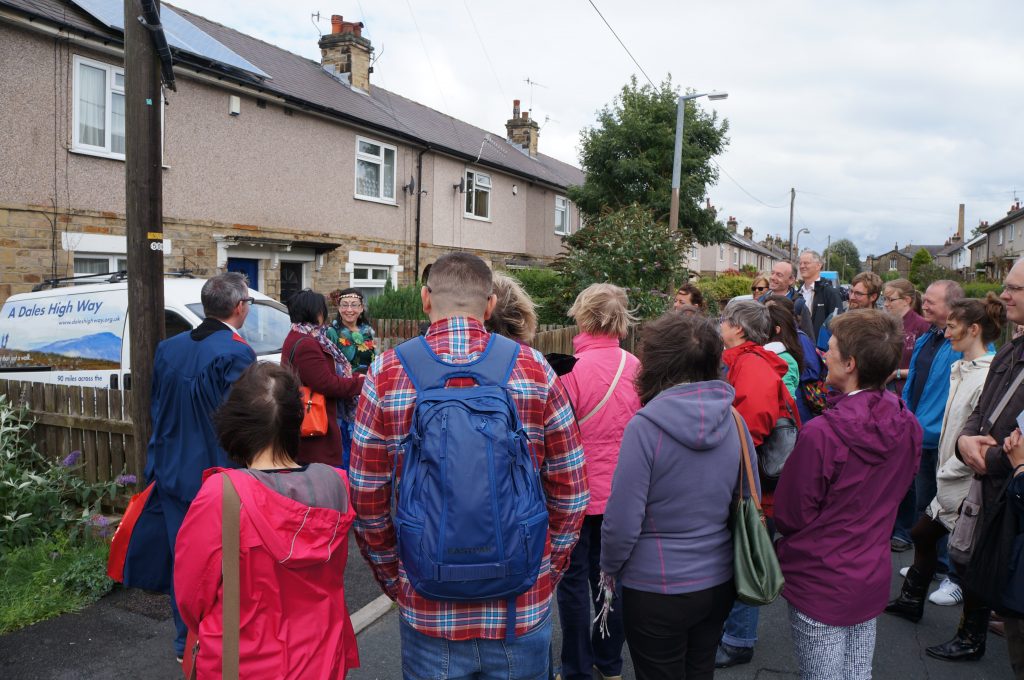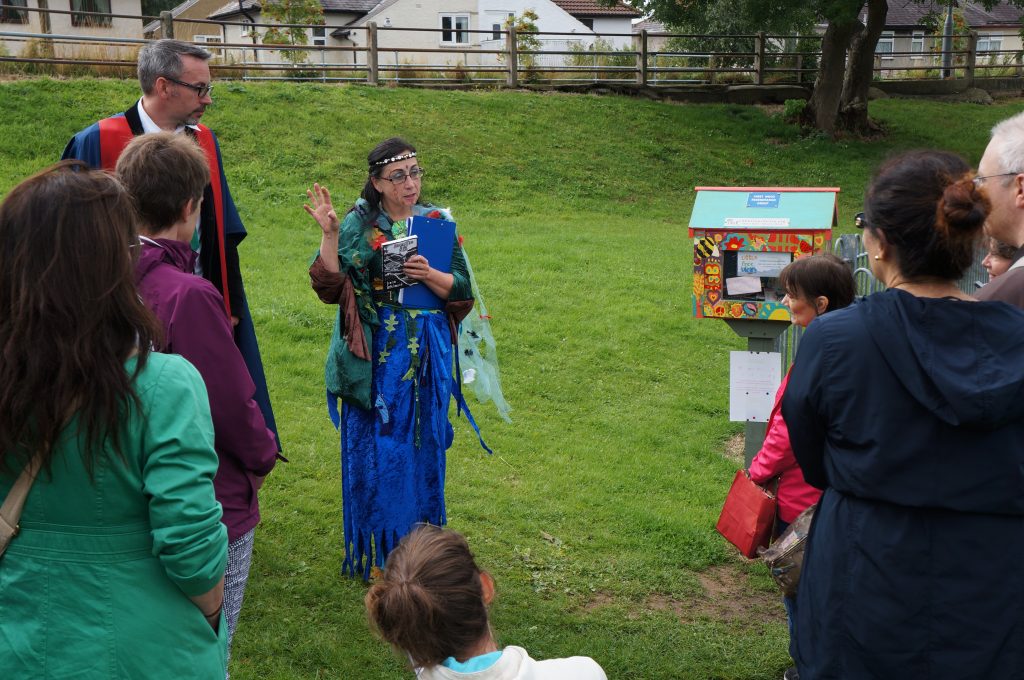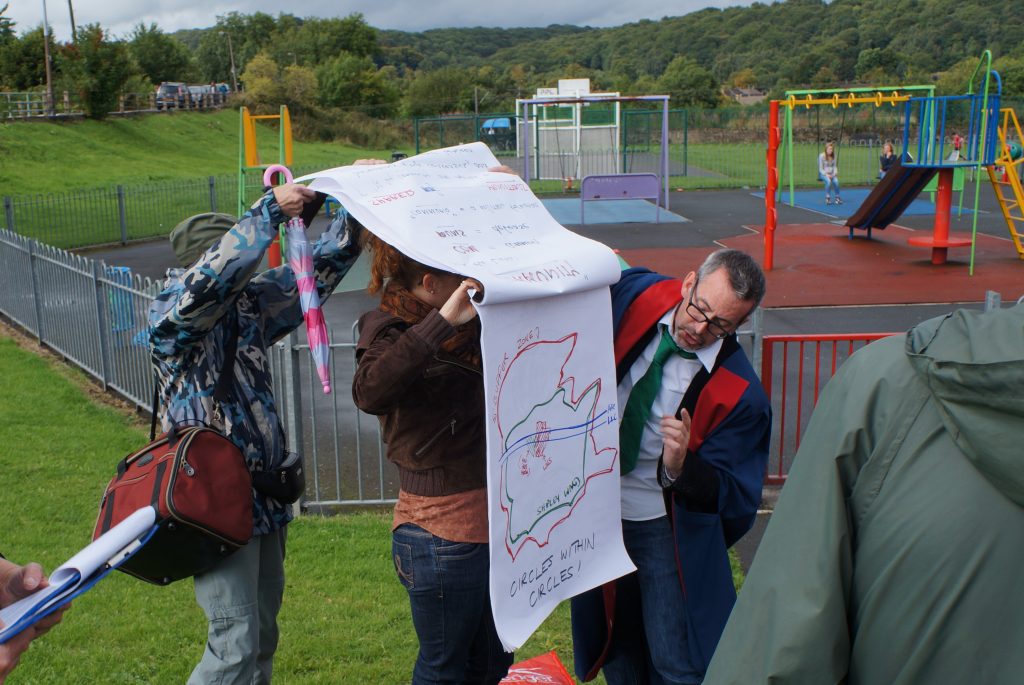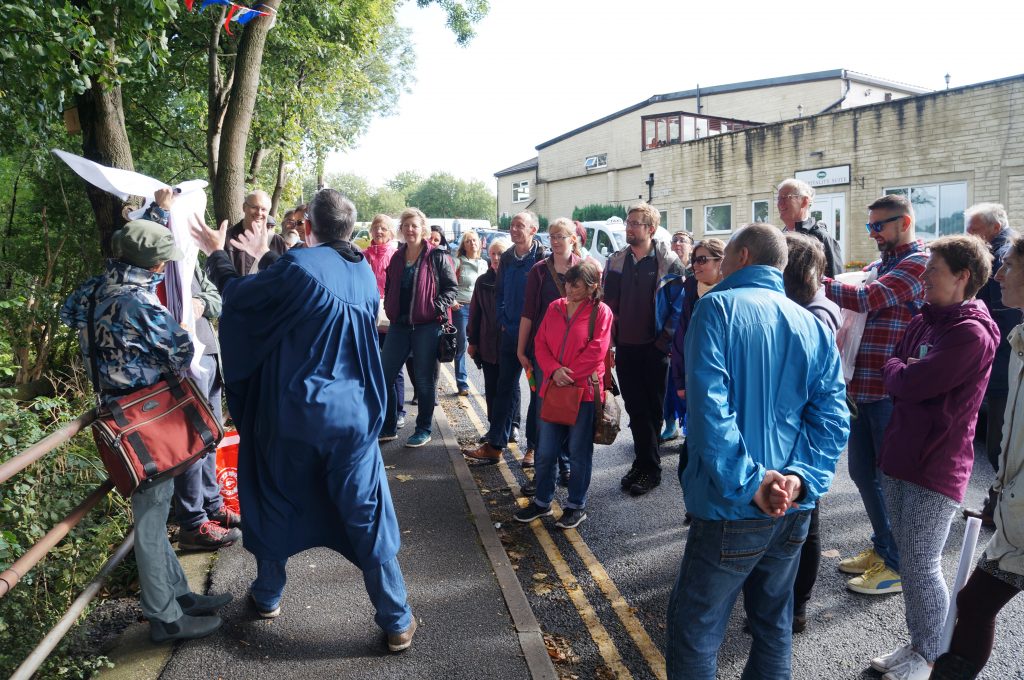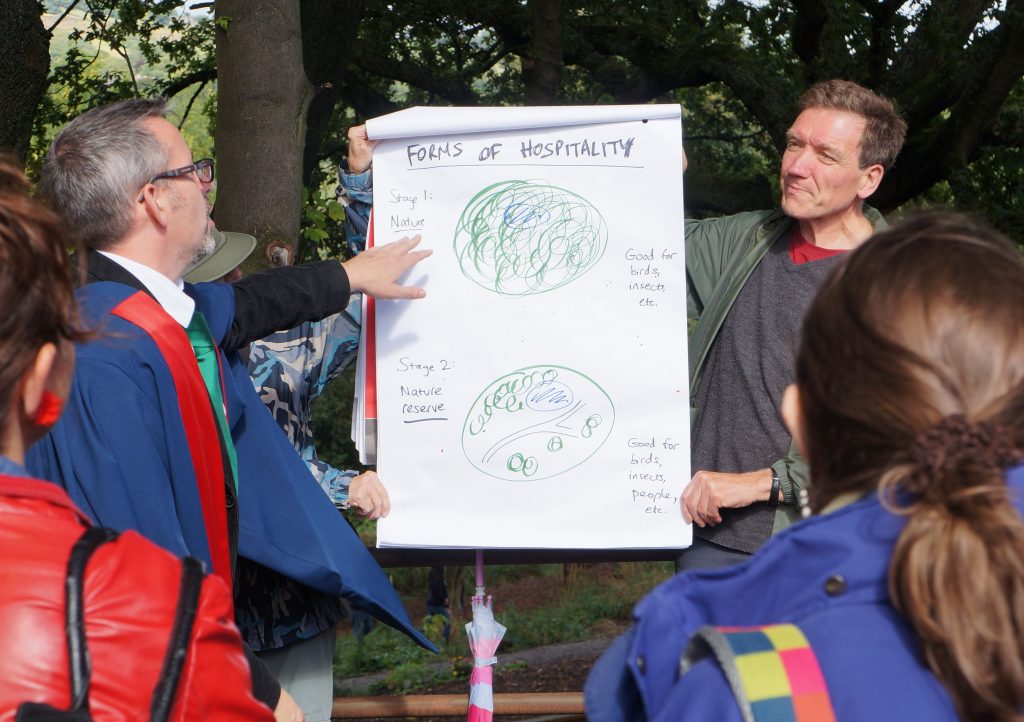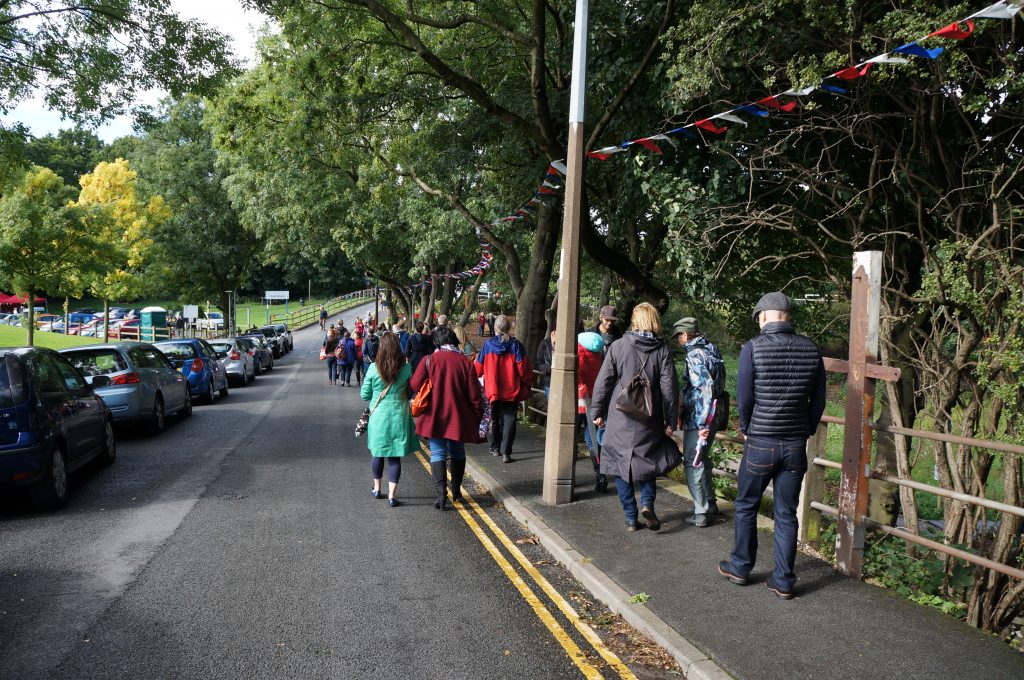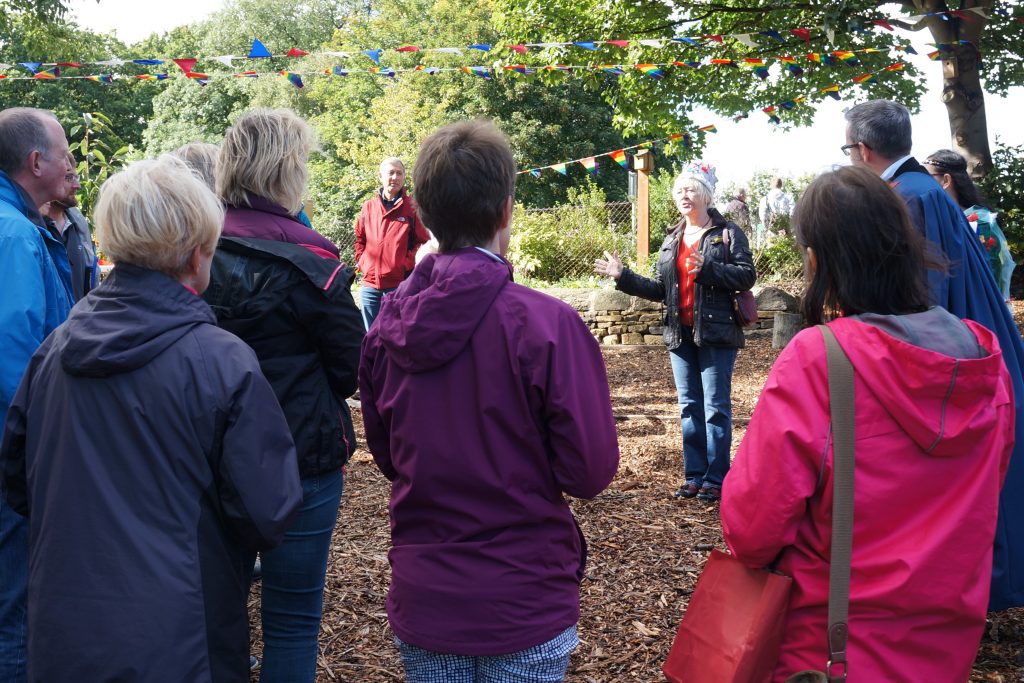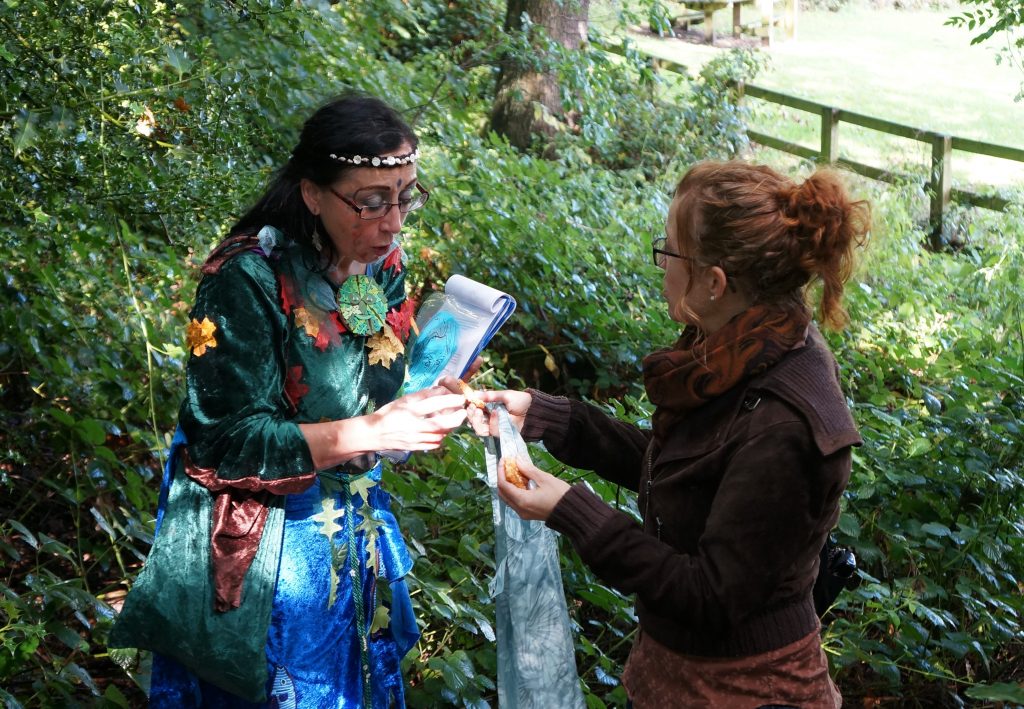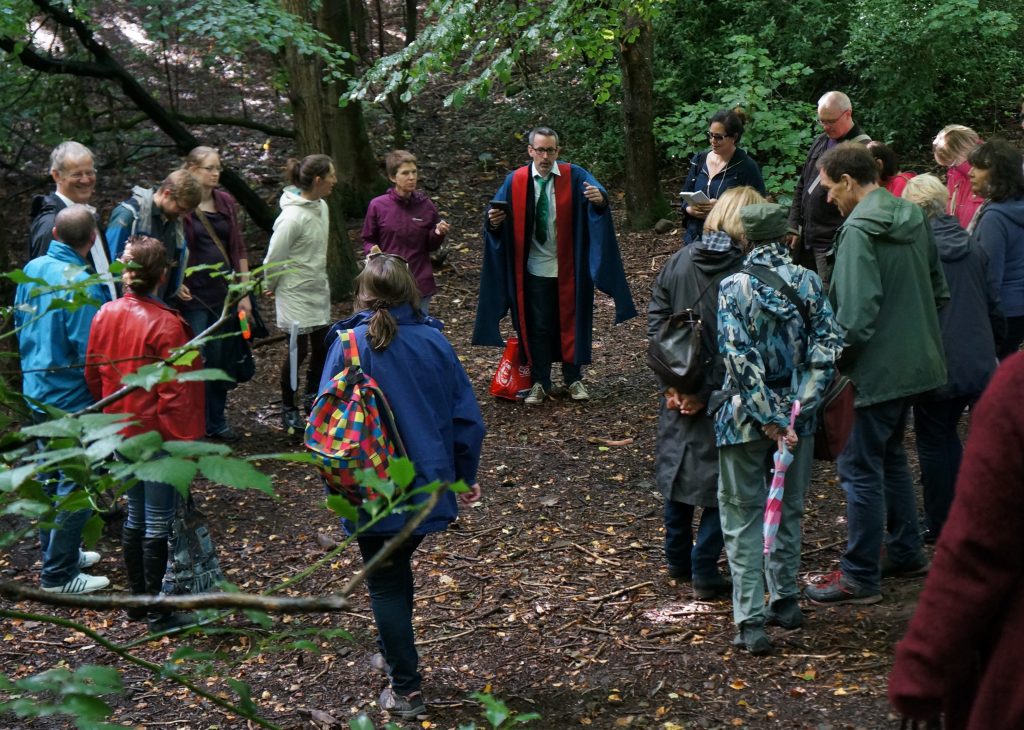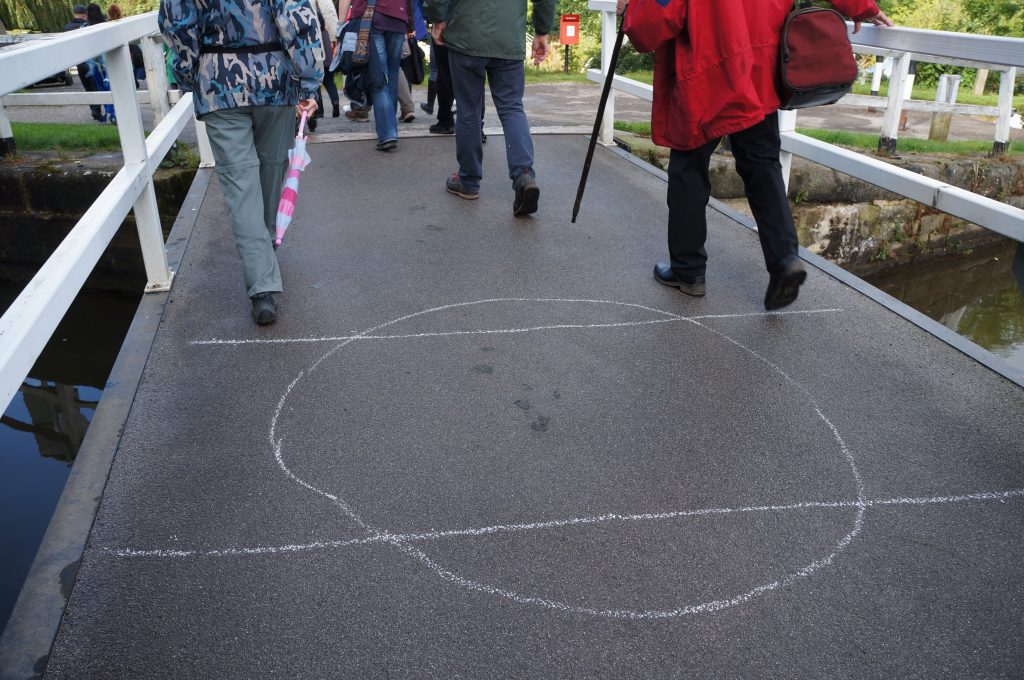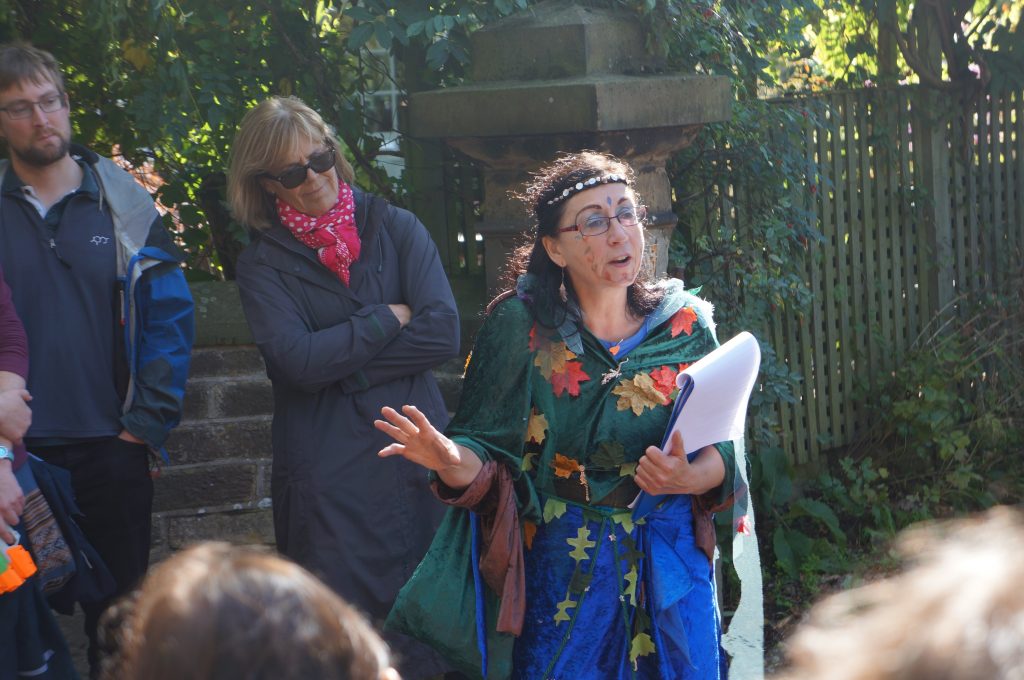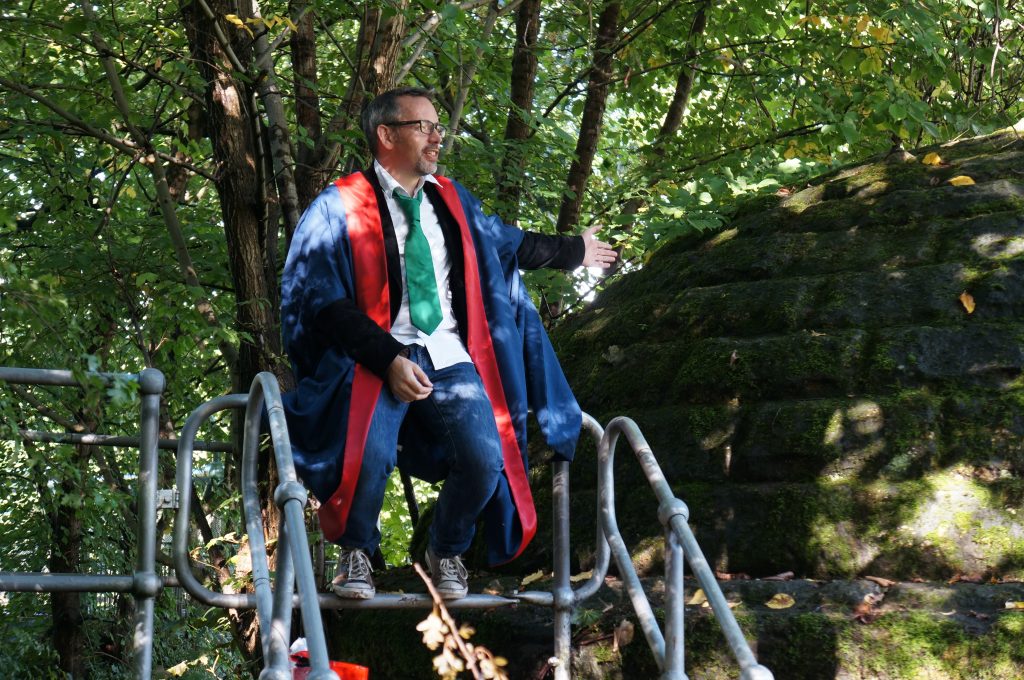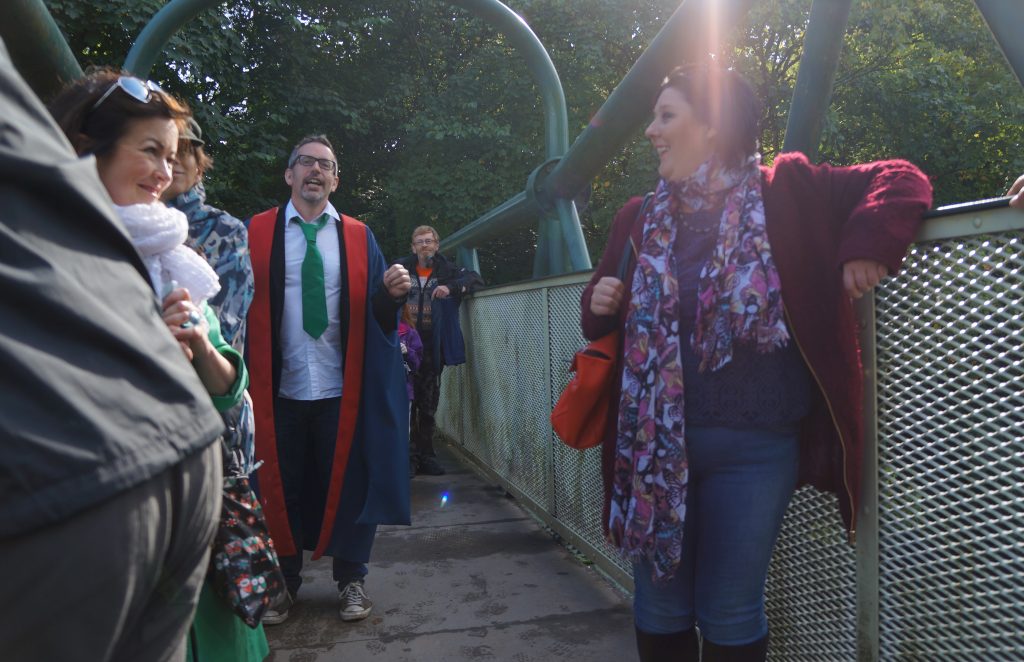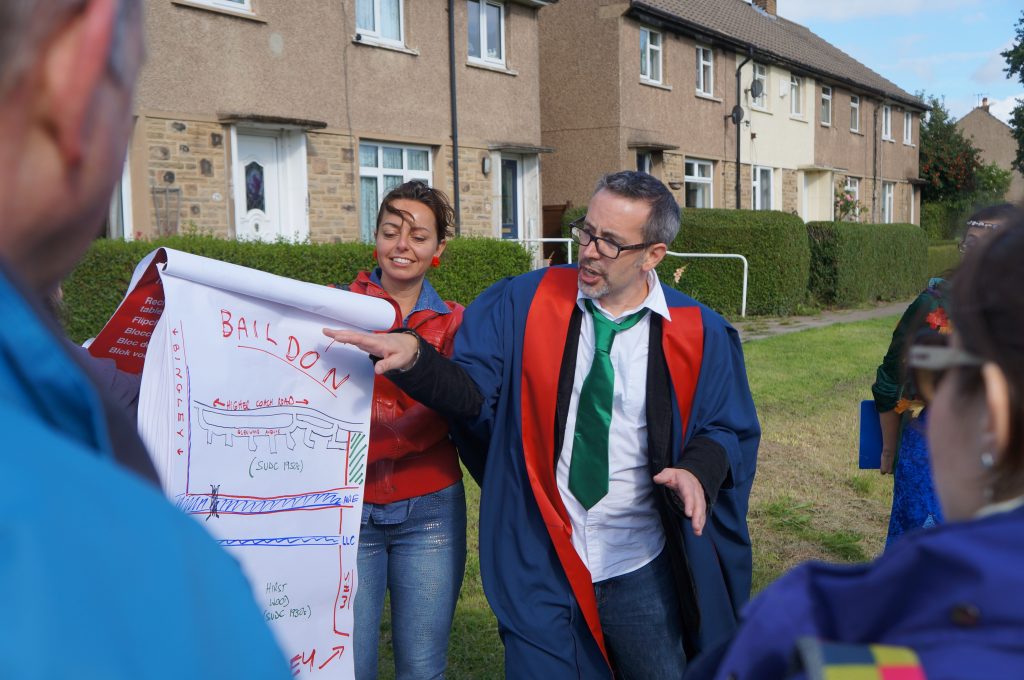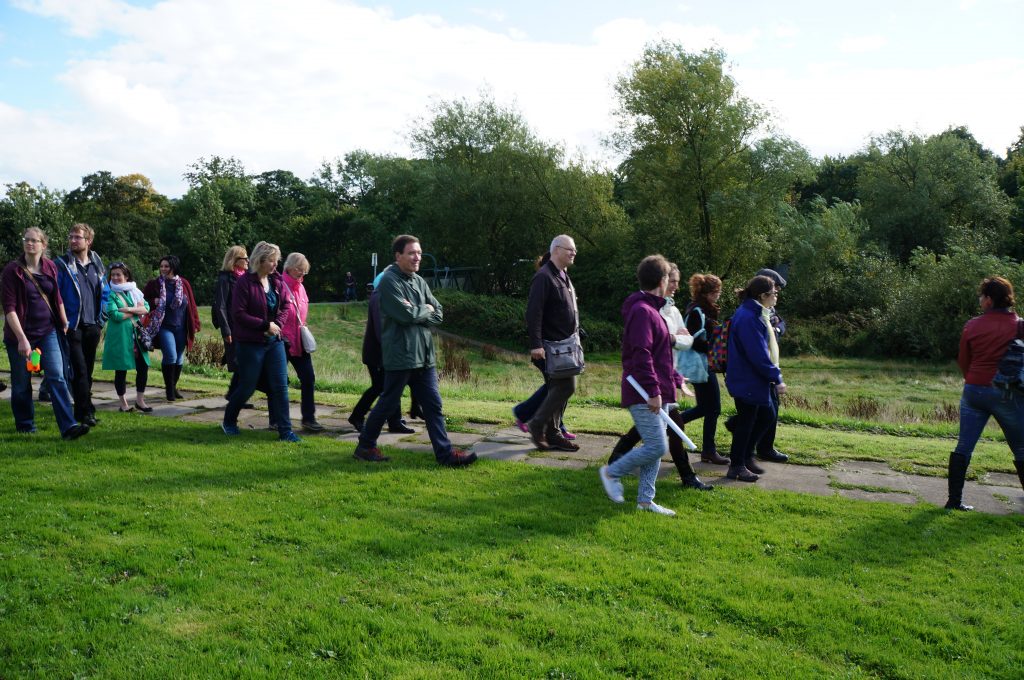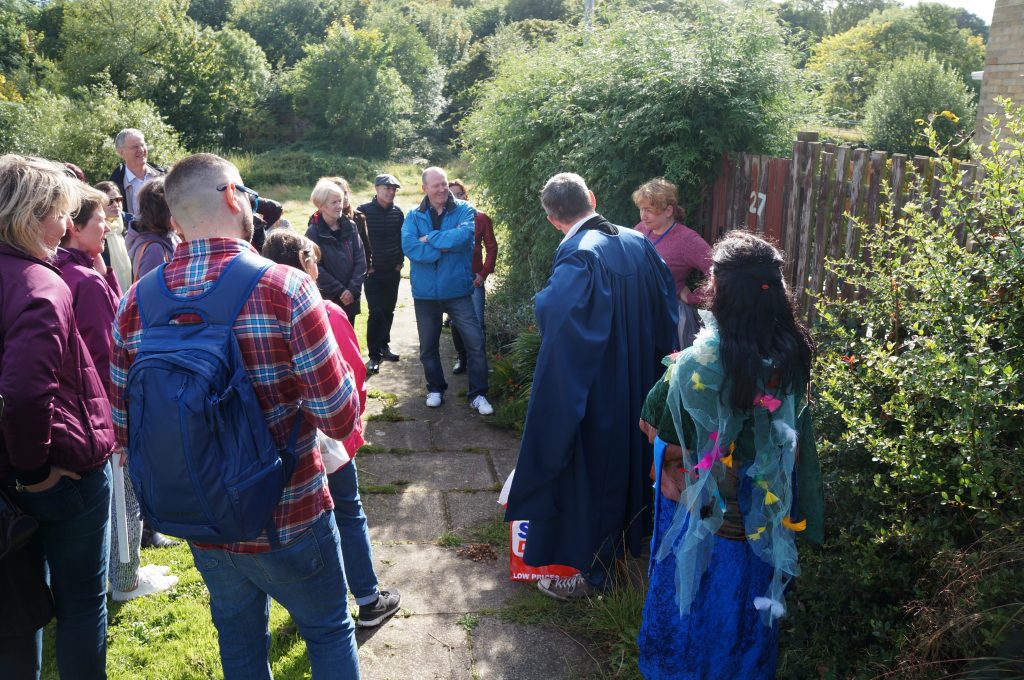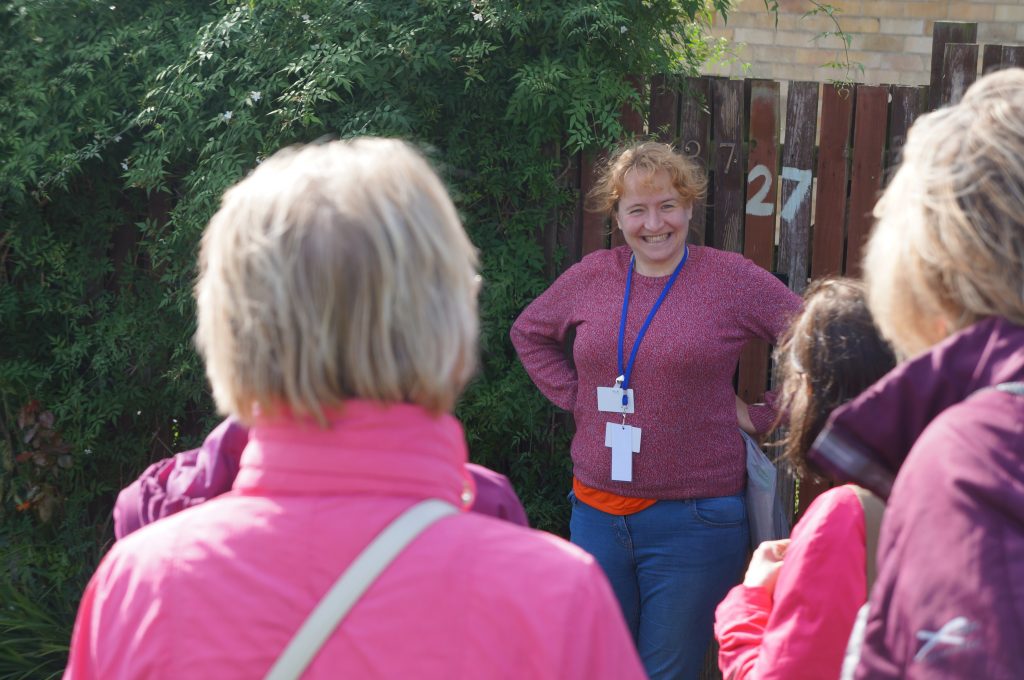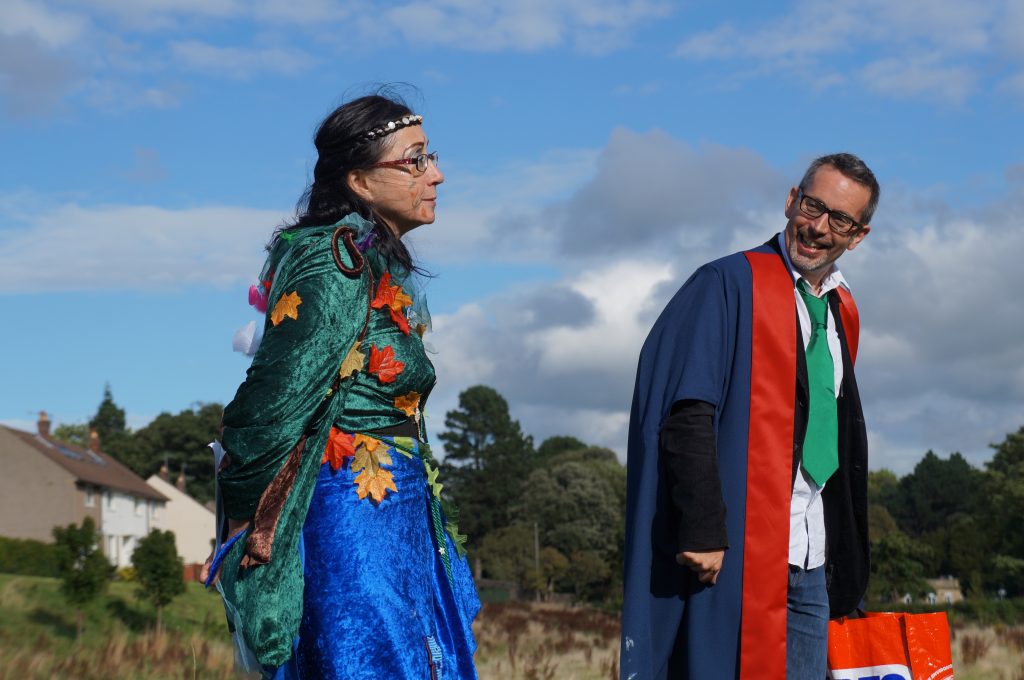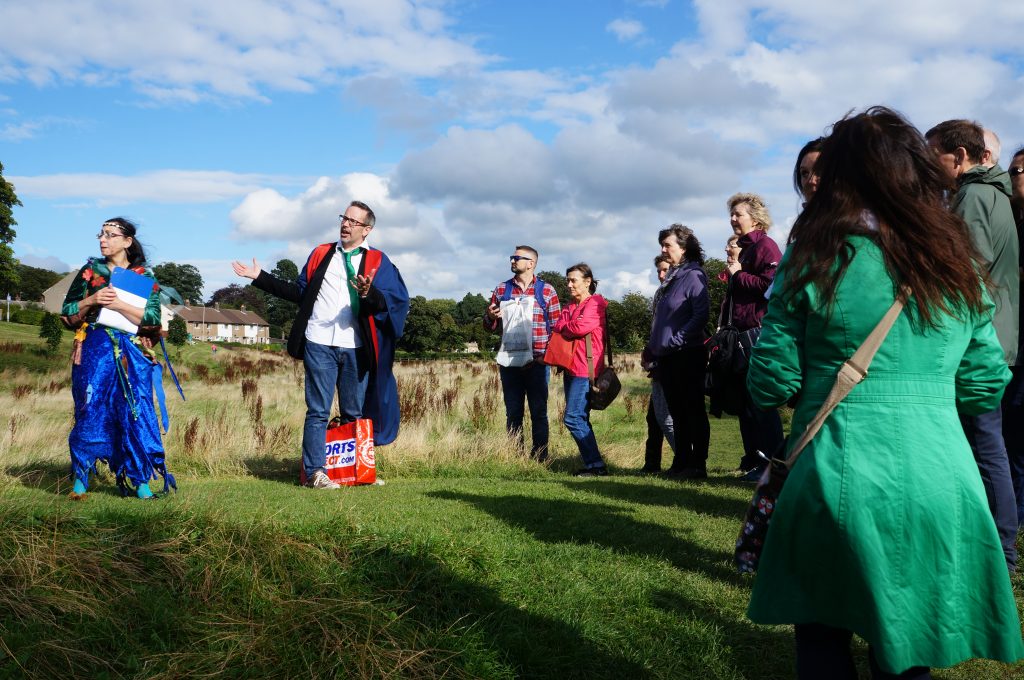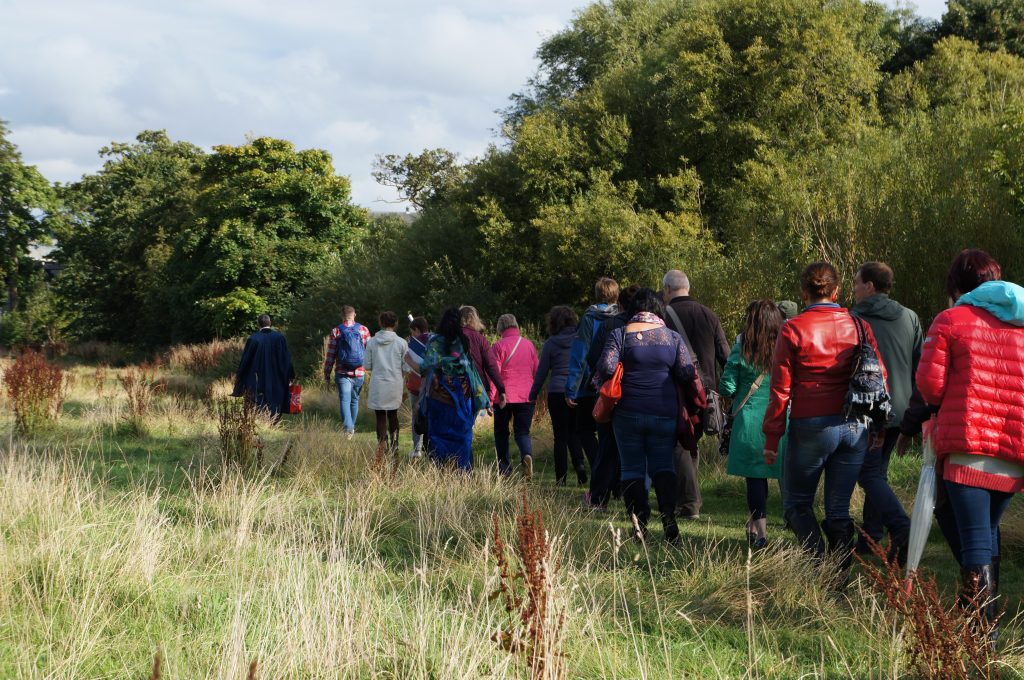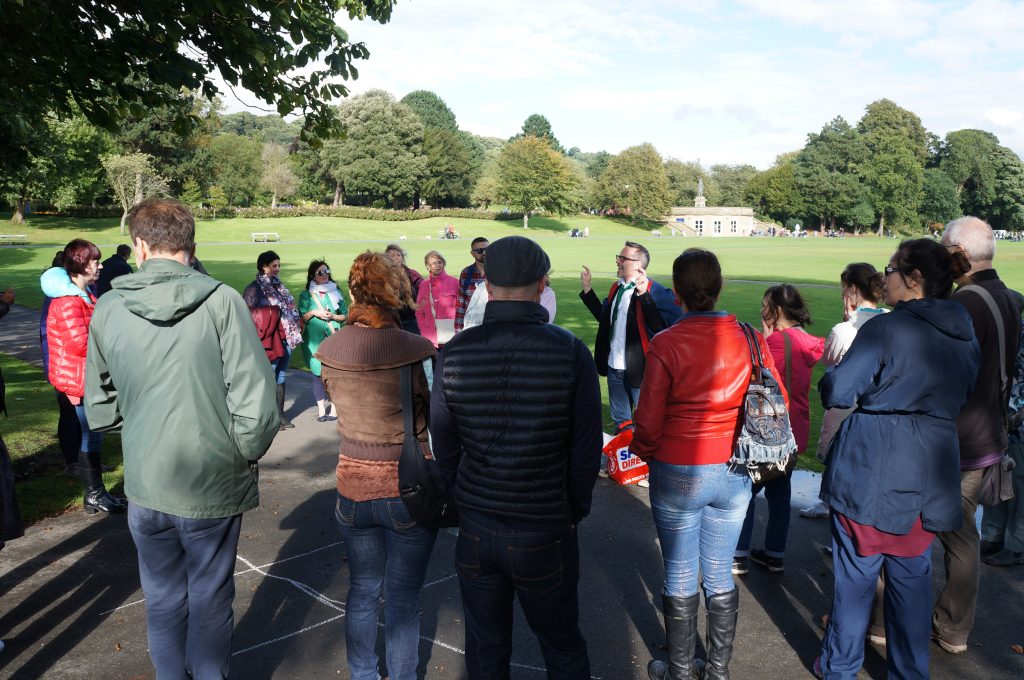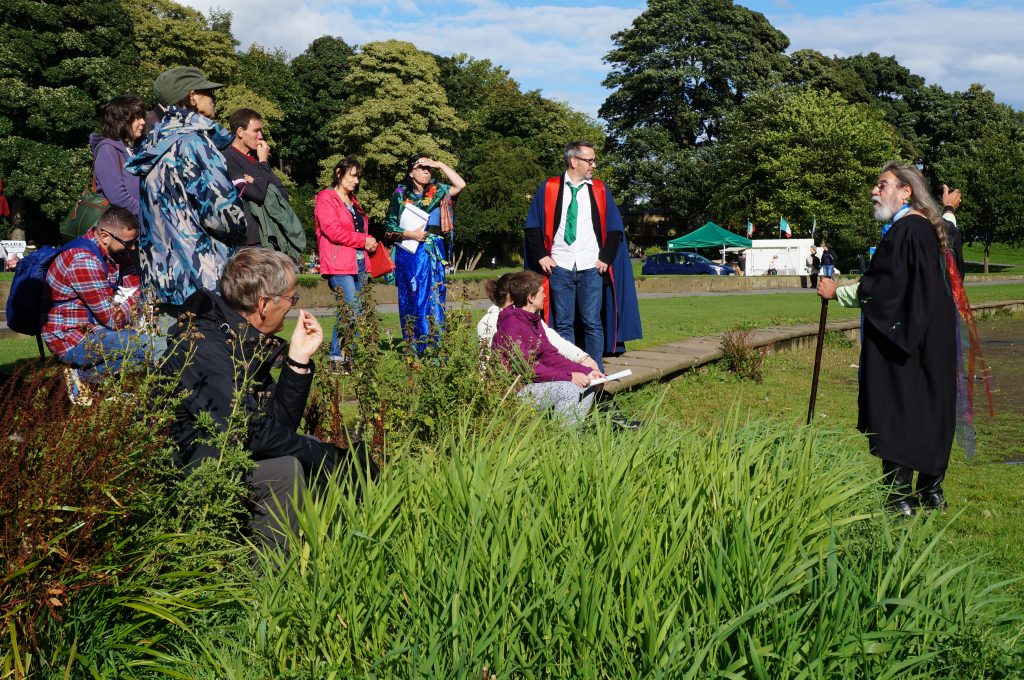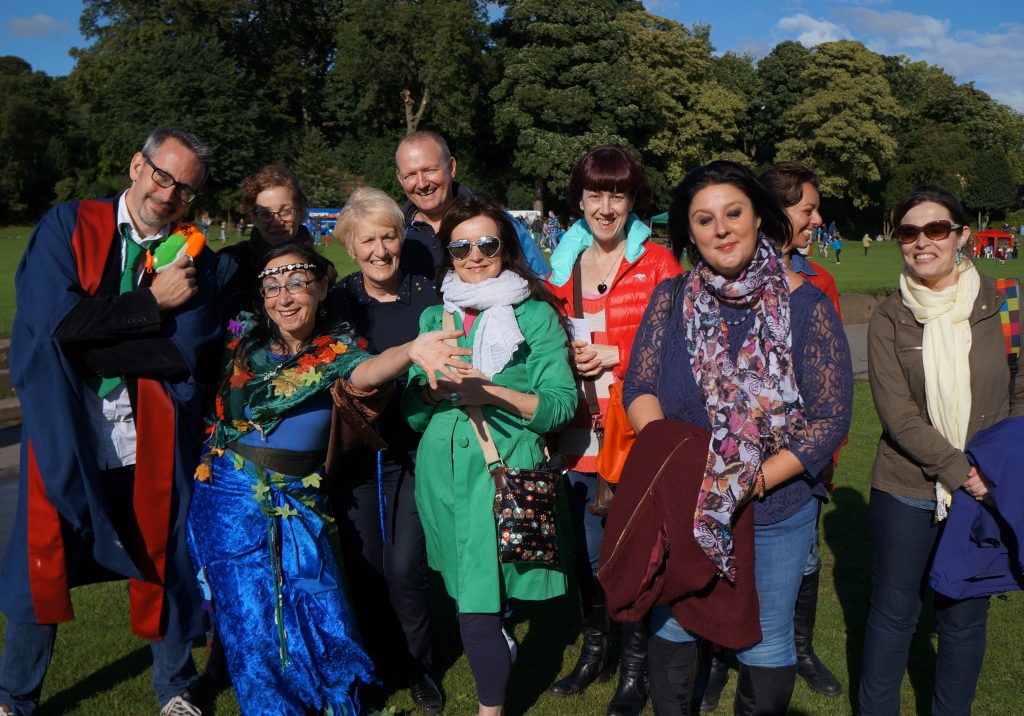Pleasant Valley Saltaire was a theatrical walking tour commissioned for the opening weekend of the 2015 Saltaire Festival (12th-13th September). Recalling Multi-Story Water’s earlier tours of Shipley’s waterways (2012-13), festival chair Ros Garside asked for something Saltaire-specific, and suggested that MSW’s Steve Bottoms might collaborate with poet and storyteller Irene Lofthouse (Fresh Aire Productions). We both happily accepted the invitation, but stipulated that we wanted the piece to try to link up the Saltaire mill village with some less well-known, less visited neighbourhoods that sit just next to it in the Aire valley, on either side of the river. Steve and Irene shared some concerns about the way that the mill village’s UNESCO World Heritage Site status has led to these other areas and their residents being somewhat overshadowed, as well as to a degree of “gentrification” in Saltaire itself. We wanted to offer a playful challenge to the familiar, rather compartmentalised approach to the area, by emphasising shared occupancy of the Airedale landscape.
What follows is an illustrated description of the tour, with photographs by Tori Watson – all taken during the first showing on Saturday 12th September. 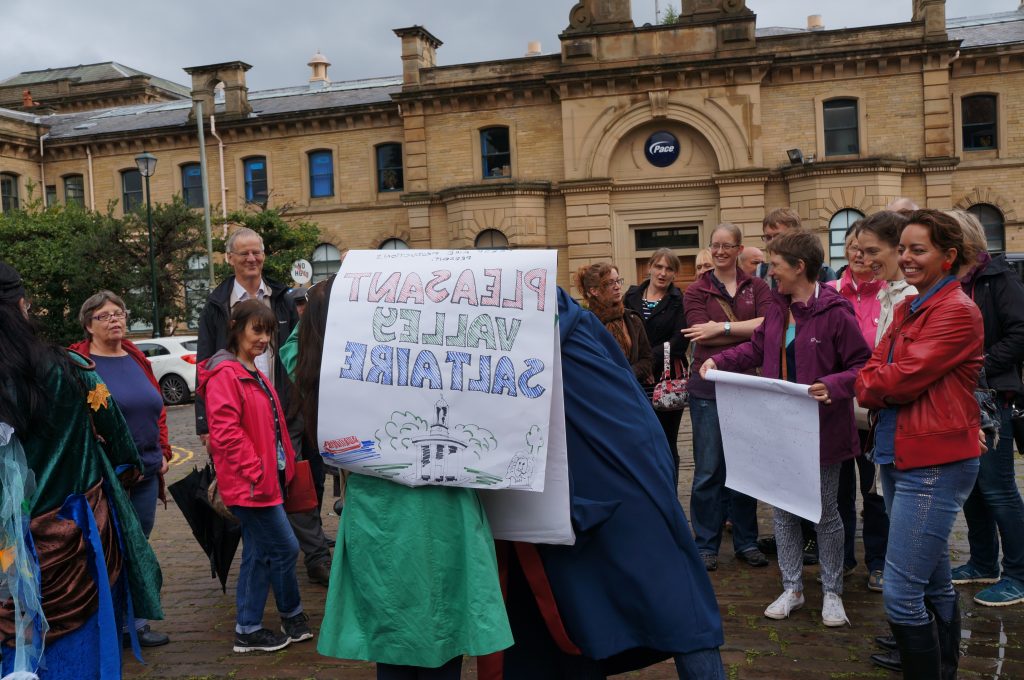 The opening weekend of Saltaire Festival is traditionally more “community” focused — meaning that it attracts a smaller, somewhat more local audience than the more commercialised second weekend (when 20,000 or so visitors typically descend on the village). We designed Pleasant Valley Saltaire to fit in with the weekend’s informal, “home-made” aesthetic (also evident in our simple flyer design, above), and took the idea of community itself as the linking thread for the tour… Appearing in academic robes and sneakers, with hand-drawn flipchart illustrations, Steve took on the role of Mad Professor, promising a roaming lecture on notions of community and group identity. To get people involved immediately in the identity of the walking group itself, the Professor enlisted a volunteer to act as makeshift flipchart stand, and asked other participants to collectively debate the answers to three multiple-choice questions…
The opening weekend of Saltaire Festival is traditionally more “community” focused — meaning that it attracts a smaller, somewhat more local audience than the more commercialised second weekend (when 20,000 or so visitors typically descend on the village). We designed Pleasant Valley Saltaire to fit in with the weekend’s informal, “home-made” aesthetic (also evident in our simple flyer design, above), and took the idea of community itself as the linking thread for the tour… Appearing in academic robes and sneakers, with hand-drawn flipchart illustrations, Steve took on the role of Mad Professor, promising a roaming lecture on notions of community and group identity. To get people involved immediately in the identity of the walking group itself, the Professor enlisted a volunteer to act as makeshift flipchart stand, and asked other participants to collectively debate the answers to three multiple-choice questions…
The tour’s starting point was in the very heart of Saltaire, on Victoria Road — just across from the main entrance to Salts Mill and outside the gateway for Titus Salt’s Grade 1-listed Congregational Church. As a crowd gathered, the Professor quizzed them about Saltaire, while asking for them to agree unanimously on the correct answers. Anyone who dissented from a group-agreed answer should indicate their independence by stepping outside the chalk circle he had just drawn around them…
Interestingly, such was the desire to remain part of the group that everyone consented to the chosen answers (even on contentious questions), and nobody stepped outside the circle. In fact, as the photograph below shows, even the much-put-upon flipchart holder-upper tried hard to indicate her place inside this newly-forming “community”…
Having established the group’s identity, we set off on our walk. Irene, appearing today as a mischievous Water Sprite, led her charges uphill — away from the water (river and canal) in the valley bottom….
… Instead, she regaled walkers with alternative liquid tales of Saltaire, such as the one about how the famously tee-total Sir Titus Salt was actually something of a wine connoisseur (true!). If he forbade alcohol to his workers, it was to avoid the risk of drunken communal assembly and potential sedition…
Leading us into Saltaire’s cobbled side-streets, the Water Sprite stopped first at the house below (at the junction of Albert Terrace and George Street), which is decorated inside and out with maritime memorabilia. The owner is a seaman, she noted, a Southerner who relocated to Yorkshire. Saltaire is today, and historically always was, a community of people who have migrated here for work from all over the British Isles…
Still, although Victorian Yorkshire attracted migrant workers from near and far, these rapidly growing industrial communities became newly divided in strange ways. In the picture below, the Professor has divided walkers into “short hairs” and “long hairs”, positioning them on either side of the street….
In the 19th century, he explains, West Yorkshire’s mill towns worked either with short-stapled wool (Dewsbury, Huddersfield) or long-stapled wool (Bradford, Halifax), and there was something of a “class” divide between the two. Saltaire, working only with the best, long-stapled mohair, from llamas, was a kind of elite location… not least because this new model village also had under-street drainage and proper sanitation pipes. Here, sewage and waste water could flow safely downhill rather than stinking up the streets — as it did in Bradford, at considerable risk to the public health.
We walk up George Street, imagining the drainage pipes underfoot…
… and then turn right along Caroline Street — part of a long, straight, clear roadway that the Sprite says was once a key transport route along Airedale. A volunteer is appointed to knock at a door, and out comes home-owner Eddie Lawler, the “Bard of Saltaire”. He leads us across to the nearby Washhouse Garden, where the Professor interviews him briefly about his longstanding role in the Saltaire village community (Eddie is one of the founders of Saltaire Festival). He then plays us a theme tune for the Pleasant Valley Saltaire walk — adapted, of course, from the Monkees’ “Pleasant Valley Sunday”.
Eddie’s song completed, the Water Sprite picks up the baton by describing some of the traditional herbal remedies grown here in the Washhouse Garden… This has always been a place of washing, cleansing, healing, in the heart of a hardworking village.
And then it’s time to move on again, continuing West along Caroline Street….
…. until we reach the threshold that is the crossroads with Albert Road. This marks the far end of the mill village. The roadway continues, but Caroline Street becomes Dallam Avenue, and Saltaire becomes Hirst Wood estate, built by Shipley Council in the 1930s.
The Professor chalks two parallel lines to represent the continuing road, then draws a curved arc (…part of an encompassing circle…) that cuts across them like a dividing line. Is this where the “community” of Saltaire stops, he asks? And if so, who are those people across the street? Are they a different tribe? (the Brigantes, Norse, Danes, Romans and Normans have all passed along this ancient route, notes the Sprite…)
… The Professor offers a brief etymological lecture on the word “community”: from “com” as in common, and “munit” as in munitions. So community means, quite literally, shared weaponry — our common defences against outsiders. Do we need to arm ourselves before travelling further? A water pistol is passed out to a member of the audience who looks like she knows how to use it…
… and then we turn right, downhill, hugging the edge of Saltaire for as long as possible, before the Sprite and the Professor invite us across the threshold. As we cross Albert Road, the Professor notes, the current average house price drops roughly in half. We’re entering a different kind of community…
… And yet Hirst Wood estate, with its pretty front gardens (no space for that in Saltaire!), is far from being an “unpleasant” part of the valley! Moving West along Albert Avenue, the Professor explains that this estate has a distinct heritage of its own — stretching back to the prehistoric cup and ring stone that was found here. Was it perhaps a way-marker for Airedale travellers…?
Outside one home we find a van parked, with the legend “A Dales High Way” emblazoned on its side. The creators of this popular 90 mile trek across the high Yorkshire Dales live right here on Albert Avenue, the Sprite explains, but since they’re off hiking this weekend (naturally), a volunteer is enlisted to read a written statement from them, welcoming today’s walkers to the Hirst Wood estate…
At the end of Albert Avenue we come to a park area, where the Hirst Wood Regeneration Group — a very active, dynamic community organisation — has installed a “Little Library”. This birdhouse-like box (on the right, above) contains donated books that can be taken away to be read, for free, and replaced with other donations. Irene presents a copy of her book Strange Tales in Bradforddale — a copy that has no page numbers, because it’s from a duff print run that will have to be pulped. This one copy has been saved, though, for donation to the Little Library (here and now, today!). What journey will this unique volume embark on from here?
The Professor resumes his lecture, extending his circles theme by considering “Circles within Circles”. Saltaire is encircled by Shipley, he explains — of which Hirst Wood is a part. But Shipley is,in turn, completely encircled by the “buffer zone” of the World Heritage Site, which restricts planning applications within the visual range of Saltaire’s landmarks. So is Saltaire in Shipley or is Shipley in Saltaire? And what about this park within a park, right here…? A sign on the fenced-off playground area specifies that adults are not permitted inside the fence unless they are accompanying children. Since none of our walkers has brought children along today, we are all excluded from this particular community location …
Our next stop in the Hirst Wood area is a more inclusive spot. Stopping on the way down Hirst Lane (heading for the canal), we’re invited to look over the fence into the brand new Hirst Wood Nature Reserve — the latest amazing initiative of Hirst Wood Regen Group, which after months of landscaping work is opening to the public this very weekend! What was once an abandoned, overgrown patch of land beside the canal is now a brand new community resource.
The Professor notes the irony, however, that “nature” was doing perfectly well on its own in this area when it was overgrown. Turning it into a “nature reserve” is actually about making the space more conducive (and inclusive) for humans too… Is this a shared community space for the human and non-human? We briefly consider how birds, fish and insects might represent themselves in a parliament of species….
Continuing down Hirst Lane, we turn finally into the entrance of the Nature Reserve — all bedecked with bunting for its opening-day party.
Here, we are greeted by our second special guest on the tour (although technically, we are guests in her nature reserve!). Pauline Bradley-Sharp is one of the chief movers and shakers in Hirst Wood Regeneration Group, and she who describes something of the enormous community effort that has gone into making the nature reserve (see this blog post for details). Walkers are encouraged to make donations in a bucket towards HWRG’s ongoing work, and then we head off across the adjacent, canalside car park and into Hirst Wood itself… stopping to consider items of interest along the way…
In Hirst Wood, the group reassembles in a clearing amongst the trees, gathering in as near a perfect circle as we can manage…
The woods, the Professor observes, are traditionally the place outside or beyond the threshold of a human community. They’re a mysterious place where dark things hide, where wolves become grandmothers, and where witches build houses of candy to ensnare children… The woods are a place where we encounter strangers — the ‘others’ who are not ‘us’ — but do those strangers bring us threats, or new opportunities? (During the Sunday walk, when Pauline Bradley-Sharp was unavailable to speak, our “substitute” guest at this point was a “stranger” to the community who spoke from amongst the circle… Professor Stephen Coleman, from Leeds University, is an expert on citizenship who shared some of his own observations on the themes of the walk…)
Emerging again from the woods, the group crosses the swing-bridge over the Leeds-Liverpool Canal, just beside Hirst Lock. In the photo above, the group is moving on after a brief, mid-bridge chalk-and-talk from the Professor… The parallel lines again represent a continuing transit route — in this case the 126 miles of the Leeds-Liverpool. The circle over the line represents the fixed communities through which barges traditionally travelled, bringing goods and gossip. Or perhaps it represents the micro-communities of men, women and children who lived permanently on the barges themselves…
We’re now on the narrow strip of land at the bottom of the valley, between canal and river. At the bottom of Hirst Crescent, in sight of Hirst Mill — for centuries a water mill next to the River Aire, though it’s now an apartment complex — the Water Sprite tells a tale of strange visitors to the mill works. Of helpful brownies, assisting in the mill, who turn into angry boggarts when neglected or abused…
Also by the river (which is on the other side of the trees in this picture), the Professor highlights another piece water engineering — not a mill but a “beehive”, a domed pumphouse that is part of the mid-19th century Barden aqueduct system, piping water down from the Barden reservoir (up in the Dales) to the city of Bradford. He also shares the tale of “the Malicious Mr. Pickles”, a Bradford farmer and human boggart who disrupted another Victorian scheme to pump water supplies towards the rapidly expanding city. By digging out (worthess) stone on his own land, he disrupted the underground flow of water to a nearby spring, feeding the then-new Hewenden reservoir. Pickles’s attempt to blackmail the city (in short: pay me not to dig) ended unpleasantly for everybody. Yet as a result, to this very day, it is still enshrined in English law that one may act with malice aforethought, in relation to the needs of the wider community, provided that one is doing so on one’s own property….
And so, finally, we cross the footbridge over the River Aire, stopping to consider the flow of water and the height it came to during the last major flood in the year 2000…
… before arriving in another Airedale neighbourhood: the Higher Coach Road estate, as built in the 1950s by Shipley Council, as part of a nationwide post-war drive for decent, affordable homes for all… And yet, as the Professor points out, Shipley built the estate on Baildon land (this side of the river is the parish of Baildon). Circles within circles…
Walking a short distance west from the head of the footbridge (in the background above) towards one of the homes overlooking the river, we knock on the gate of estate resident Ruth Bartlett…
Ruth tells us a little about living on the estate, beside the river (again, it’s behind the trees in the background of the picture above). Familiar neighbours here include herons and kingfishers…
… but Ruth also tells us about her wider experience with communities of otherness, working for the British Embassy in Paris (and even co-organising a visit from the Queen). With a referendum on European Union membership on the cards for next year (2016), where do we draw the lines between who is or is not our neighbour..?
From Bowland Avenue, we begin walking eastward, along the length of the Higher Coach Road estate… back towards Saltaire itself, along the riverside track beside the trees… As we walk, the Sprite shares tales of her friends, the river birds and fish…
Midway along the length the estate, we pause on a raised ridge in the grassy floodplain (a ridge built up over water pipes, emptying into the river…), to consider two points of discussion in the Higher Coach Road community. One is the lack of a proper footpath beside the river… the track gets muddy and churned up in winter…
… The other is the overgrown, unmown state of this field. Controversially, Bradford Council has not been mowing this space regularly through the summer, because of forced spending cuts. Residents on the estate are divided over whether or not this is OK: some like the wilder, more natural look (it attracts more insects, and thus more birds to watch from your window…); but others feel that the human residents here are being treated as second-class citizens, in relation to other places where the grass is still being neatly cut…
… and so we lead off again, along the riverside path (the one stretch here that is being mown!) towards the gate leading into Saltaire’s Roberts Park, where the grass is immaculate, particularly on the cricket pitch…
Again, the Professor’s chalk markings delineate a continuing path (from estate to park, beside the river), but a broad arc cuts across it. Entering the park, we’re re-entering the World Heritage Site of Saltaire (even though the rest of the village is on the other side of the river and canal). Are we, again, crossing a line of community division, or relative privilege? What does the height of the grass tell us? What about those newly planted trees along the border of the estate: are they part of a deliberate attempt to screen out “the harsh urban edge of Coach Road”, for park visitors..? (see final section of this blog)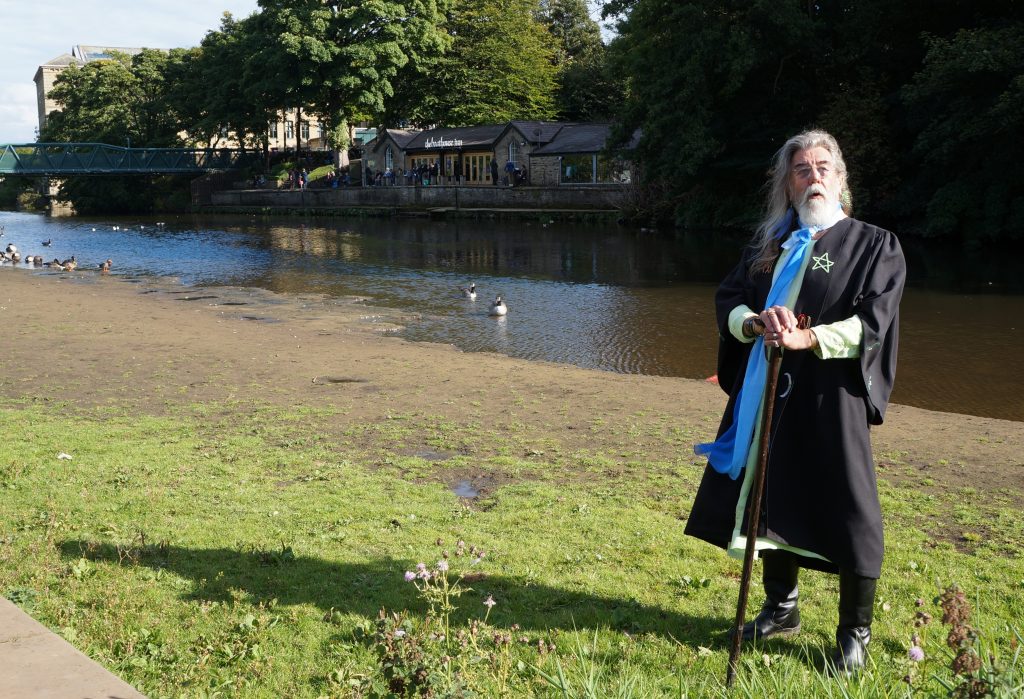
We walk on along the park’s riverside path, leaving contentious issues behind us to enjoy the sunshine… On the water’s edge, despite the very low late-summer river level, we come across a final contributor to our tour. This is Isara, the River God (played by former Saltaire Village Society chairman, Rob Martin). Our Sprite introduces him, and he shares some concluding thoughts for today’s pleasant valley journey…
Welcome to the bank of my river, the river Aire.
My name is Isara,
From the ice to the space age I have delivered fresh water
From Malham Tarn to Airmyn
Through limestone, and millstone grit
I bring life-giving water.
In return you have filled me with shit.
I freely give my power to your looms,
In return you damn my progress
to provide for your sport, in boats, canoes and with rod.
Taking my children with hooks disguised as gifts.
Despite your cruelty I survive and will live on.
You ask now for my clean power to brighten your homes.
What do you offer in return?
…
In bygone times, Rombald the giant and the Brigantes gave me gifts
But what am I offered now?
Charcoal-scarred grass and discarded cardboard chicken.
Take care as you enjoy this scenery
Your progress brought me near death
Nature needs nurture
Look after me, I am your future.
(speech by Rob Martin, 2015)
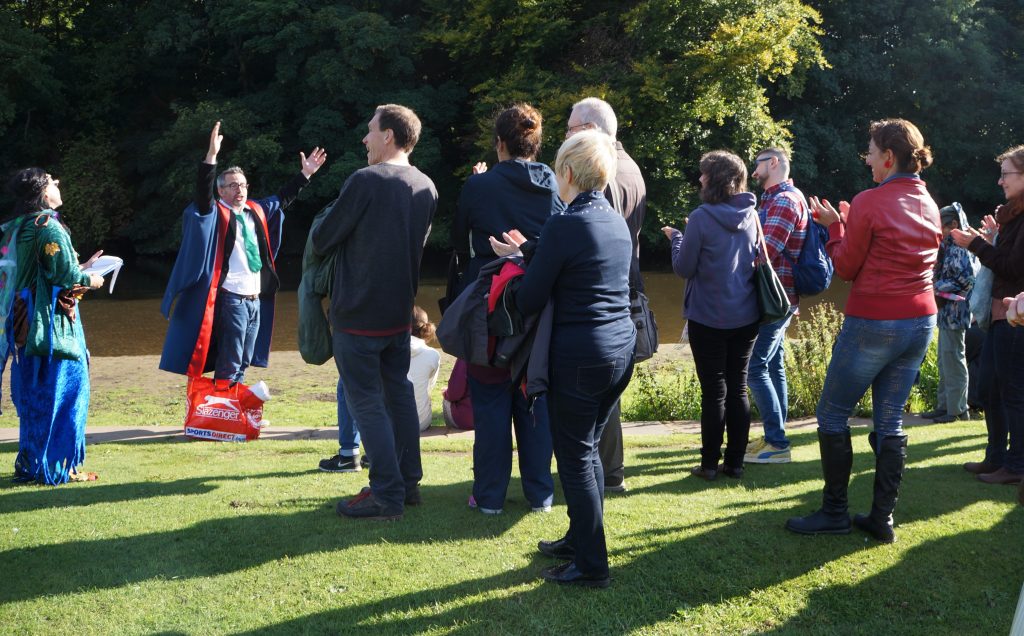 And with that, the tour concludes. As the walkers applaud, the Professor offers a final, sung blessing, courtesy of the poet Gertrude Stein:
And with that, the tour concludes. As the walkers applaud, the Professor offers a final, sung blessing, courtesy of the poet Gertrude Stein:
“I leave you there / Do not, do not despair
Remain in a circle and do not despair.”
As people start to drift off, one group of walkers requests a selfie with the performers. They are effusively enthusiastic, which is particularly gratifying given that — thanks to the group walking somewhat slower than expected — the tour took closer to 2 hours to complete, rather than the advertised 90 minutes. Not everyone stayed with us all the way round, of course (and why should they, on a day like this?), but the group visibly picked and lost up casual spectators along the way… a flowing, transient community…
(Note to self: in 2016, we’ll try making shorter performances…)
Pleasant Valley Saltaire
12th-13th September 2015, Saltaire and surrounds
Devised by and featuring:
Steve Bottoms as the Mad Professor
Irene Lofthouse as the Water Sprite
Rob Martin as Isara, the River God
with special thanks to our special guests:
Eddie Lawler, Pauline Bradley-Sharp, Stephen Coleman, Ruth Bartlett – as themselves
(and thanks also to certain invisible Frenchmen for the Professor’s theoretical inspirations: Etienne Balibar, Jacques Derrida, and especially Bruno Latour)

